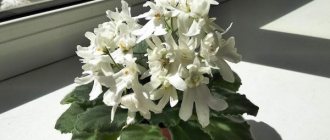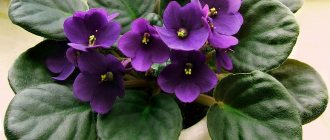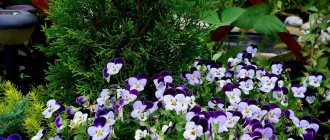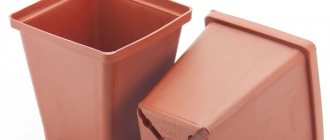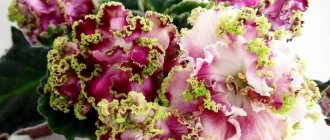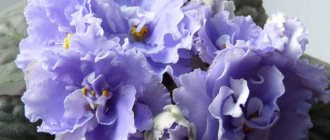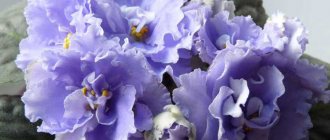Violets are very popular and sought-after indoor plants. With their decorativeness and variety of species and varieties, they captivate the hearts of flower growers.
Breeders managed to develop many forms and colors of this unique crop.
In this article I would like to talk about unusual varieties of green violets (Saintpaulias) and some secrets of caring for them.
After all, an important element of successfully growing a plant you like is studying its characteristics, and the experience of other gardeners helps a lot in this direction.
Description
First, let's give a description of the Green Rose violet.
Its leaves are large and slightly wavy at the edges. The predominant color is beautiful, rich dark green. Growth proceeds from the center to the edges, resulting in the formation of a strong rosette.
You may be interested in: Indoor Hippeastrum flower: care at home
But, of course, the main feature of the variety is its gorgeous flowers. They consist of numerous petals with wavy edges, arranged in the same way as in rose flowers - hence the name. At the edges the petals are pale yellow or even light green. There are also exquisite inclusions – strokes of lilac color. During one flowering, 6-7 flowers are usually formed. Moreover, with a new flowering, the shade and structure of the flowers can differ significantly - this makes the growing process especially interesting. Colors can also be affected by ambient temperature. If the temperature drops below +20 degrees Celsius, then light colors predominate - yellow and light green. But if the room is hot - above +26 degrees - then a large number of purple and even crimson inclusions appear on the petals. Of course, when choosing a sprout, any florist expects that it will retain the characteristics of the parent plant. However, this is not always observed in violets. Quite often, a young plant has flowers of a different color, very different from the flowers of its parents. Such specimens are usually called “sport”. Violet Green Rose is no exception. Therefore, you should be prepared for this.
Names of varieties of violets: with white leaves, with a green or white border, double
White violet is a small plant belonging to the Violet family. Originates from countries in the northern hemisphere, but is also found in Hawaii, Australia and the Andes. There are more than 500 species and hybrids in this genus. Blue violets are the most common and are easy to grow in the garden. The most decorative type is terry.
The burgundy violet with a white border is gaining popularity among gardeners. The violet with snow-white leaves of the Pauline Viardot variety is very prized. The lilac violet Zemfira has gained widespread recognition due to its original appearance. With so many choices, it's hard to decide which of these endlessly fascinating plants to choose for your landscape.
Either variety is equally attractive and easy to grow.
Characteristics and cultivation
Saintpaulia (the second name for violets) is a small rhizomatous plant that does not reach more than 30 cm. Thanks to various hybrids, the inflorescences can be of any color, although the most characteristic color for this plant is the one that gives it its name. The rosettes are usually simple, the flowers can grow isolated or collected in inflorescences, but they always have five petals.
Variety of indoor violets
Saintpaulia is a plant that needs a lot of water, so it needs to be watered two to three times a week to keep the substrate moist. In addition, it is very important that there is a good drainage layer at the bottom of the pot.
As much as possible, it is recommended to avoid direct use of tap water as chlorine is harmful. It is also not recommended to water at night, as low temperatures may damage the hairs covering the plant.
For your information! The first hours of the morning are best for watering.
If the leaves are dusty, they should not be wiped with a cloth, as they are easily damaged. The best option would be to spray warm water so that the dust simply drains away along with any remaining moisture.
Violets prefer shade rather than direct sunlight.
Growing violets
Types and varieties of violets
Hydrangea paniculata - the best varieties for the Moscow region
Those violets that regularly grow in parks and gardens are called African violets (Saintpaulia Ionatha). However, these plants are not actually a variety of classic violets, although they share the same flower shape.
What types of violets should I pay special attention to?
African violets owe their popularity to their wide range of colors. In the plant world, there are white, blue, pink, green, purple, etc. In addition, the petals may have white spots or edges. They can also be two-tone or multi-colored.
With border:
- Iceberg. It has quite remarkable star-shaped double inflorescences;
- Through the Looking Glass. Semi-double inflorescences of this variety have a border;
- Rose of Wind. The inflorescences of this violet are a bit like ordinary garden roses;
- Natalis Estravagante. Lace inflorescences with a multi-colored border;
- Beautiful Creole. The flowers of this variety are star-shaped;
- Modern Talking. The corollas of this violet are white, and the border is usually purple or blue;
- violet-flowered. The flower has heart-shaped rosettes, short stems and a large rosette.
Beautiful violets with a border
Burgundy:
- Goddess of beauty. The leaves are large and dark. Double flowers;
- The magic of love. This variety has double flowers;
- Black Prince. The flowers are double and resemble a star.
White:
- Alice Blizzard Baths. Alabaster flowers resemble stars and are quite modest in size. The petals are semi-double, the rosettes are bright and heart-shaped;
- Snow lace. Double flowers with a border and a blue spot in the middle;
- The bride's bouquet. Large milky flowers are star-shaped;
- The Snow Queen. Semi-double flowers of medium size, round rosettes.
Blue varieties of violets:
- Blue dragon. Large inflorescences have a light green border;
- Blue Danube. The inflorescences of this Saintpaulia reach 5 cm in diameter. There are small teeth at the ends of the leaves;
- Blue Lagoon. The inflorescences have a full border and a blue spot in the center.
Pink:
- Georgia. Large double inflorescences have a rich color and a thin border of light green;
- Marquise. This variety has a rich pink hue and a blue border;
- Magdalene. The inflorescences are large, double, and resemble a ball. The edging is wavy;
- another name for an unusual pink violet with a green border is Winter Smiling.
Purple:
- Currant dessert. The petals have a fringe of an unusual color. The leaves of this unpretentious plant are velvety;
- Winter rose. The shape of the inflorescences is very similar to rose flowers and has a white edge. The leaves are small and rich in color;
- Baltika. The variety is classified as semi-double and has a wide edge. Leaves with toothed tips;
- Rosemary. The inflorescences are double, star-shaped with bright white streaks. The leaves have serrated edges.
Lilac:
- Chanson. The flowers look like bells. The plant blooms for a long time;
- Zemfira. Flowers are single or semi-double. The leaves are colorful;
- Satellite. The rosette is small, and the flowers are brightly colored.
Note! Breeders have long tried to develop a variety with yellow flowers. In nature, Saintpaulias do not have a gene that would be responsible for this color. Only at the end of the 20th century. one breeder managed to get a yellow variety. No one knows his name.
Classification by leaves
Hydrangea paniculata white, red, pink - the best winter-hardy varieties
Few people know that the color of violet inflorescences and leaves is inherited together, since this is influenced by its genetically linked characteristics.
Varieties with almost black leaves have a burgundy or purple flower color, while those with light leaves have white flowers. But sometimes hybrids appear that stand out from the crowd and attract attention. They look extremely impressive.
Light Frost and Orchard's Night Light have an almost black rosette and white inflorescences. There are also varieties with white leaves.
Varieties of violets with names can puzzle even the most experienced gardener. In some cases, a description of leaf color can help identify the plant variety.
Collectors rarely pay serious attention to the coloring of the reverse side of the sheet, but breeders never make such an oversight. Only a small number of plants have silver, pink or red undersides. Typically, silver-green is characteristic of plants with white and pink flowers, and the red back is characteristic of purple and burgundy varieties.
Unusual violet leaves
Speaking about colors, it is worth mentioning the variegated color and its variants. The variegated mutation is valued for its decorative properties. In this case, abnormal groups appear among normal cells that lack green pigment. Variegation comes in different types: in the form of spots, stripes or streaks.
In any case, all violets are worthy of attention and detailed description, but within the scope of this article a superficial introduction is sufficient. Each variety has unique characteristics, so any gardener will choose a suitable specimen for himself, and maybe several at once for his collection.
Source: https://pocvetam.ru/komnatnye-rasteniya/sorta-fialok.html
Suitable soil and pot
You may be interested in: Watering cyclamen at home: rules for caring for an indoor flower
Before you start breeding violets, you need to take care of suitable growing conditions. There are several subtleties here that are very important to know about.
First of all, the pot. It would seem that everything is simple here - any container with drainage holes in the lower part will do, so that excess moisture can be freely removed without leading to rotting of the root system. However, the size of the plant should be taken into account here. It is not worth planting a tiny violet in a large pot. Otherwise, the plant will devote all its efforts to developing the root system. This will take many months and all this time the violet will not bloom - hardly anyone will be happy with this situation. Therefore, it is advisable to plant a small leaf with roots in a small pot. Then the root system will quickly occupy the entire available volume and the plant will finally begin to bloom. Over time, the grown plant will need to be replanted - we’ll talk about this a little later.
You may be interested in: How to plant Decembrist plants at home: rules and tips
The choice of soil also needs to be taken very seriously. It is advisable to use fertile soil - black soil or any other soil mixed with compost - an excellent fertilizer. If the soil is too dense, then it would be a good idea to slightly dilute it with sand to facilitate the passage of moisture and oxygen to the roots.
Of course, it is advisable to pour a little crushed stone or pebbles at the bottom of the pot, and only then pour soil on top of them - then the plant will develop most quickly.
Correct conditions
In order for the violet of the Green Rose variety to actively grow and develop, it is necessary to provide it with certain conditions. First of all, these are humidity, temperature and lighting. Let's look at each of the parameters in more detail.
Like most violets, this variety prefers high air humidity - 50% or more. However, at home, this indicator is quite difficult to maintain - especially in winter, when radiators and heating devices dry out the air. Therefore, it would be a good idea to use a special humidifier or simply spray the plants with a spray bottle once or twice a day.
In general, violets are not too demanding on temperature conditions, successfully developing in a fairly wide range. But still, they grow best at temperatures from +18 to +30 degrees Celsius. As mentioned above, the appearance of flowers depends on this indicator.
Any plant needs a sufficient amount of light so that the process of photosynthesis actively occurs in the leaves. In summer there are usually no problems - there is enough lighting. True, you need to make sure that the violet does not get burned from direct sunlight - it is better to place the pot not on the south side. Otherwise, overheating will cause the leaves and flowers to wither and then dry out. But in winter there is clearly not enough light. Therefore, in order for the plant to develop successfully, it is necessary to provide them with a sufficient amount of artificial lighting. Fortunately, coping with the task is not at all difficult - just install a fluorescent lamp on the window.
Violet Flower
Violet is a houseplant from the herbaceous family. The birthplace of this culture is Tanzania. The plant was discovered and described by Baron Walter von Saint-Paul at the end of the 19th century. Growing these flowers is very simple, and even a novice gardener will not encounter any serious difficulties. This article describes the best violets and the features of their cultivation.
Indoor violet
Indoor violets are small and grow in a compact, beautiful bush. The stem is short. The leaves are green, oval, emerging from a rosette. They are located on long petioles and covered with small fibers. The leaf can be up to 8 cm in length!
Photo of violet “Wedding bouquet”
Interesting!
Violets are a sign of prosperity and rebirth. Depending on the color of the flowers, they have their own special energy. Thus, a white violet is a symbol of purity, blue is a symbol of love, blue is a symbol of creativity, purple is a symbol of spirituality, and red is a symbol of optimism.
Photo of violet "Lyubasha"
the plant will develop. It is very important to be able to choose the right pot for young violets. Flowers are capricious in this matter! This crop has a small root and does not require much soil. The violet should be about 3 times larger than its pot. Based on this, you can choose a good pot.
Interesting!
You cannot choose a pot for growing violets! Flowering in this crop is observed only after the roots have entwined the entire container in which they are located!
It is better to purchase soil in a store - especially for violets. But if you don’t want to spend money on soil, you can make it yourself. To do this, mix garden soil and a little sand. After this, the resulting mixture must be calcined or treated with potassium permanganate to destroy harmful microorganisms. A third of the way, the pot is filled with drainage, and an earthen substrate is poured on top.
Planting is carried out carefully so as not to damage the fragile roots. At the same time, the cuttings cannot be deeply buried, otherwise young leaves will not appear soon.
Flower care at home
Indoor violets are easy to care for, but so that they do not get sick and grow normally, they are provided with normal conditions.
Photo of violet “Beautiful Creole”
- Violets love light very much. Good lighting should be available for 14 hours. In this case, it is necessary to darken these flowers from the bright sun so that burns do not appear on the leaves.
- The temperature in the room where violets are grown should be within +18...+25 in summer, and +10...+15 degrees in winter. These flowers do not like the cold. In winter, they should not be kept on cold windowsills. From the cold, the roots and leaves of plants can begin to rot or wither. For this reason, in winter they must be placed on wooden stands and moved away from the windows.
- Humidity should not be low. If the air in the house is dry, you need to place flowers in trays with wet expanded clay or place a humidifier nearby.
Interesting!
Different types of violets require the same growing conditions. Many lovers keep entire collections of a wide variety of varieties in their homes.
- How to water? Violet does not like waterlogging or dry soil. It should be watered as needed when the top layer of soil begins to dry out. In summer, 2 waterings per week are usually sufficient, and in winter – 1 time per week. Water for irrigation is taken settled, rain or filtered. You need to water so that the water does not get on the growth buds. Because of this, these flowers are usually watered using the drip method or a watering can with a thin spout.
Important!
Spraying is harmful to violets. Drops accumulate on the leaves and do not evaporate, causing rot to develop.
Photo of violet "Duchess"
- Fertilizing is necessary only in the spring, when the buds are forming. In summer, autumn or winter there is no need for fertilizing. For this you can buy special drugs. Nitrogen fertilizers provoke the development of green mass, and potassium-phosphorus fertilizers promote lush flowering.
- Transplantation is usually carried out in the spring. This is the most favorable time. In winter it is too cold, in summer it is too hot, and in autumn the growing season ends and the plant simply cannot take root normally. Replanting is necessary after purchasing a new flower, when diseases, pests, soil depletion appear, as well as for rooted cuttings.
Problems when growing violets
Difficulties in growing violets arise in rare cases. They are usually associated with improper care.
- Why don't violets bloom? Indoor violets under normal conditions grow well and bloom regularly. But it also happens that the plant stops blooming. What to do in this case? You need to pay attention to the pot. If it is very large, then the violet simply will not be able to bloom until it grows - the plant gives flowers after the roots have entwined the entire earthen lump in the pot!
- Why do the leaves turn yellow? Violet leaves usually turn yellow when the soil is depleted. In this case, either fertilizing or transplanting to new soil can help. Photo of the “Green Lagoon” violet
- What to do if the leaves become pale? Pale leaves indicate a lack of light. At the same time, the bush stretches upward (toward the light). Lack of light usually leads to the fact that the crop gradually fades. For the problem to disappear, it is necessary to provide the violet with better lighting.
Interesting!
Violets do not emit allergens, so they can be grown even by people prone to allergies.
Diseases and pests of violets
Indoor violets rarely get sick, but this also happens with insufficient attention to the culture. Among the infections and fungi that are dangerous for this plant are: powdery mildew, gray rot, and fusarium. In addition, the violet can be affected by nematodes, aphids, mites or thrips.
When diseases appear, it is necessary to use special preparations (Fundazol, Skor) for spraying. As a preventative measure, the fungicide “Fitosporin” is used. And in the event of pests appearing on the plant, treatment is carried out with insecticides such as Fitoverm, Regent, Mospilan.
Source: https://fermerok.info/tsvetok-fialka
Germination and planting
Now let's talk about the propagation of Green Rose violets. Flowers are quite easy to germinate. If you see a beautiful plant from your friends, you can simply ask them to separate a single leaf from it. Of course, it is advisable to choose an even, beautiful and large leaf, and not from the edge, but directly from the center - they receive the most nutrients, which is why they are the most viable. After that, half the work is already done!
All that remains is to place the leaf in a small container of water. Make sure that the lower end (cut) is always in water and never dries out - this will lead to the death of the plant. But at the same time, only the cutting itself should come into contact with water, and not the leaf - otherwise excess moisture will have a bad effect on it, and even rot may appear.
After a few days, small roots will appear at the bottom of the leaf. So it’s time to plant the plant in the ground. What soil and pot to choose is described above. All that remains is to moisten the soil well, dig a small hole in it, place a leaf there so that all the roots are in the hole, and carefully cover it with soil on top, lightly compacting it for density. That's all! Now the plant will probably actively grow and develop.
Violet
Many of us love to grow beautifully flowering indoor plants on our windowsills. One such plant is the green lagoon violet.
This variety attracts many gardeners with its unusual white-green flowers. Caring for the “green lagoon” violet is practically no different from caring for other varieties.
Let's take a closer look at the description and features of growing this flower.
Photo and description of the violet variety “Green Lagoon”
This plant, as mentioned earlier, has an unusual color. The outer petals of the “green lagoon” violet have a greenish tint, their main color is white. The petals have streaks of a bluish tint.
The shape of the green lagoon violet flower is also very unusual; in appearance it is somewhat similar to cabbage forks. However, gardeners often complain that the flowers begin to darken with subsequent blooms.
If the plant is not renewed, it will eventually form a dark purple variety.
You should also pay attention to the fact that the “green lagoon” violet, the photo of which is presented in this article, blooms infrequently. However, this disadvantage is compensated by prolonged flowering.
When looking at the photo and description of the “green lagoon” violet, it is imperative to mention that the plant produces from 4 to 5 peduncles, on which large flowers are formed. The first ones are the largest, and the subsequent ones can be smaller.
What else can be said about the description of the violet variety “green lagoon”? This plant blooms for the first time approximately 2 years after planting. In hot weather, violets have less of a green tint and more of a bluish tint. In cooler weather, the petals take on a greenish color.
The leaves of this variety often rise upward; this is a varietal feature of the “green lagoon” violet, the care of which will also be described below. The buds of the plant are quite heavy, and the flower stalks are weak, so the raised leaves seem to support the flowers, so the bouquet does not fall apart.
This variety is often subject to various diseases, in particular, rotting of the rosette itself. Many people complain that the flowers begin to dry out inside before they have time to bloom. To prevent all this from happening, you need to familiarize yourself with the peculiarities of growing “green lagoon” violets at home. We'll talk about this in the next section.
Features of care
Violets prefer light, which plays a huge role during flowering. It is also not recommended to keep the plant in direct sunlight.
Particular attention should be paid to watering the plant, since due to severe waterlogging of the soil, the roots begin to rot, as a result of which the violet dies.
All violets need high humidity, but spraying is not recommended for this, as this procedure leads to the formation of spots on the leaves.
Many also often encounter rare flowering, which occurs with long intervals.
In this case, the flowers stay on the bush for a short amount of time, wither quickly, and have recumbent or very long peduncles.
Improper care can also cause the color to fade quickly, so you should not expose violets to direct sunlight on the windowsill. Also, these crops are afraid of the slightest waterlogging or drying out.
That is why, before purchasing a violet of the “green lagoon” variety, be sure to ask yourself whether you can provide proper care for this plant.
With proper care of your indoor plant, it will delight you with wonderful flowers, and flowering will occur frequently.
Source: https://podokonnik.temadnya.com/1696396698349210440/fialka-zelenaya-laguna-foto-i-opisanie/
| Modern violets are the result of almost a hundred years of work by breeders. The work is complex, not easy. After all, like all living organisms, Saintpaulia is subject to variability, hereditary or non-hereditary. Sometimes it is not easy to retain the varietal characteristics of a violet. External and internal factors have a great influence on the type of plant. Who knows, maybe this variability helped breeders get “green Saintpaulias,” find the key to the secret, and then fix this color. Of course, it is impossible to talk about green flowers in the full sense of the word. Not a single variety has pure green flowers. Currently, a green violet is a plant that has a green border or a green tint to its petals. The main color can be any. Currently, there is an “explosion” of interest in these varieties; many varieties of green violets have already been created. What needs to be done to make the green color appear most brightly? The saturation of this color directly depends on the temperature and is best manifested if during the period of budding and flower opening it does not exceed 20*C. In this case, the outlet should receive regular feeding, and the pH of the soil should be within 6-6.5. Sufficiently long daylight hours and high air humidity are also required. Green is a combination of blue and yellow. On the one hand there is boundless energy, and on the other there is an all-consuming calm.
Green violets keep their secret, the secret of life, and are a symbol of softness, calmness, and sometimes even hypochondria. They have a calming effect on restless people, creating a feeling of harmony and trust. Violet Green ApolloBreeder : Lebetskaya E. Violet Green applesBreeder: Korshunova E. Flower: Large double star-balls with bright light green outer petals. Rosette: Rich green leavesSize: Standard Violet Green DragonBreeder: Brownlie Description: A cap of white and green roses rises above the variegated foliage. Half miniature. Violet Green LagoonBreeder: (Sorano). Description: Large semi-double and double light blue stars with a dark blue eye, a wide reddish-purple ruffled border and a light green-golden edge. Large dark green foliage. Violet Green RoseDouble white-pink flowers with brownish-green corrugated fringe. Wavy leaf. Violet Green coralsBreeder: Repkina S. Flower: Original simple blue-white stars with wide gray edges and bright green fringe. Rosette: Medium green ruffled foliage. Size: Standard Violet Green knotsVery large double magenta flowers with almost black tips of the petals and a wide green fringe at the tips of the petals, which seems to be “twisted” into knots. Exhibition rosette of green pointed leaves. Bright and exotic bouquet Violet Green MossBreeder : Repkina S. |
A little about watering
Violets should be watered as the soil dries. Accordingly, this will have to be done more often in the summer, and less often in the winter. In addition, the soil dries out faster in small pots than in large ones.
Watering should be done only with settled water - not cold from the tap. It is advisable to pour water into a suitable container - a glass, jar or any other with a wide neck (to facilitate the process of chlorine evaporation) and leave for a day. During this time, it will warm up to room temperature and get rid of dangerous chlorine. Too hot or cold water may well lead to diseases and damage to the roots.
When watering, try to pour water directly onto the ground. If it gets on the leaves on a hot sunny day, burns are possible - white spots will appear on their surface.
Transplantation
It was already mentioned above that violets need to be replanted regularly. Up to one year it can easily grow in a small pot. But then you should transplant it into a larger pot and repeat the procedure every two years.
Old plants especially cause a lot of trouble. It is not enough to simply replant them - you need to carefully remove the outer leaves directly from the rhizome, leaving only the middle. This rejuvenation of plants leads to active growth.
With young violets everything is much simpler. You need to prepare a pot into which you plan to transplant the plant, pour soil into it and make a large depression in it. The soil in the pot with the violet needs to be slightly moistened, and then carefully turned over, trying to shake it out along with the plant - here it is very important not to damage the root system, otherwise the violet will hurt and may even die. All that remains is to place the soil in the prepared hole and water it well.
Botanical features of Saintpaulia
Saintpaulia descended into the caring hands of flower growers from the mountain ranges of Tanzania and Kenya. The flower in its natural habitat can be found at the foot of waterfalls and along river banks, where air humidity levels are most optimal for it.
The unpretentious plant has gained such popularity due to its staggeringly long flowering period, sometimes reaching ten out of twelve months of the year! The convenient size also played an important role: you can grow a whole collection of different varieties of violets on the windowsill.
Having obtained the sprouts, until the onset of the most beautiful growing season, flower growers very often do not even realize what kind of Saintpaulia variety they got. Despite all the variety of varieties bred over centuries, all violets have some common characteristics. These include quinquefoils with a diameter of 2 to 4 cm, forming a racemose inflorescence, as well as a calyx from which five sepals originate. The plants themselves are small and lush. Several short stems, a basal rosette and dark green or spotted leaves covered with fine hairs are a few more distinctive features. The violet fruit can be easily recognized by its capsule shape, which contains countless small seeds inside, each with a straight embryo.
Don't forget about fertilizers
For the first six months after planting in fresh soil, there is no need to fertilize the violet - the soil contains all the necessary substances. Then you need to feed the flower every two weeks - this is especially important during the flowering period.
An actively growing plant needs to be fertilized with nitrogen fertilizers - they ensure rapid growth of green mass (stems, leaves). Immediately after transplanting, you can add a little phosphorus, which is needed for the rapid development of the root system. But before flowering, you need to fertilize the violet with potassium fertilizers - then there will be more buds and their size will also increase.
Of course, when fertilizing, carefully study the instructions so as not to harm the plant due to excess microelements.
Possible difficulties during cultivation
Most often, violet lovers encounter aphids and mites. The appearance of aphids can be noticed by the gradually curling leaves. The problem is solved after treating the leaves with a special powder preparation - Mospilan.
Mites most often appear on old, drying leaves. Therefore, if you spend at least a few minutes a couple of times a week removing dry leaves, you will probably not encounter this problem.
